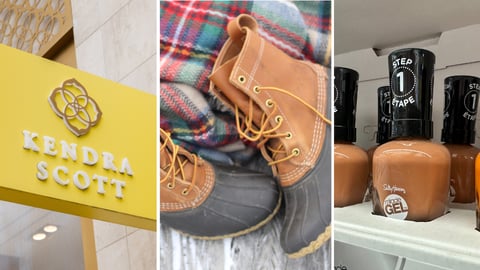Media Training: Nearing Half-Year Mark, CEO Chavern Details Consumer Brands’ Priorities
As he approaches his six-month anniversary of becoming president and CEO of the Consumer Brands Association, David Chavern finds his background in digital media serving him well.
Chavern, who assumed the helm of the trade organization for consumer goods manufacturers and retailers at the start of the year, joined after seven years at the News Media Alliance, a non-profit representing over 2,000 digital and print journalism organizations, and over a decade at the U.S. Chamber of Commerce, where he started the first U.S. Chamber office focused on technology and innovation.
As a result, many of his current conversations with the 70-plus manufacturers and retailers in the Consumer Brands organization ring familiar.
“A lot of the things that they're looking at from a business perspective are things like data flows, connecting with the consumer, more effective but deeper marketing relationships, [and] connections with retailers,” he noted to CGT in a recent interview.
Chavern took the new role in part because he was entranced by the scale and influence of consumer goods companies, and he’s determined to impress that upon more consumers as the leader of an organization representing over 1,700 brands. “There really aren't that many other industries that have that sort of scale and daily impact on people's lives.”
And while perhaps emblematic of some universal truths across industries, this close focus on media-related issues, including first-party data and retail media networks, wasn’t something he necessarily expected and has proven to be a pleasant surprise.
CGT caught up with Chavern to learn what he’s hearing from today’s consumer goods leaders and what’s next for the Consumer Brands Association. What follows are edited excerpts from the interview.
Challenges of Today’s CPG Leaders
In helping manufacturers navigate today’s challenges, Consumer Brands tends to bait for the big fish — particularly issues requiring cohesive efforts. Today, this means helping them with packaging and sustainability commitments, something all of its members have set.
Advancing more sustainable packaging solutions, however, requires effective recycling systems, Chavern noted, which is currently an incredibly fragmented ecosystem in the United States.
Their efforts to solve for this are focused on two levels: One is focused on improving and standardizing the current mechanical recycling programs, including through consumer communications. The second is propelling advanced recycling, or chemical recycling on plastics, which involves reducing plastic products down a molecular level and creating new products with them, which could in turn improve supply chain resiliency.
At the end of the day, companies view their sustainability commitments as inherent to their business, Chavern said, as it impacts their supply chains and costs.
“The burden of figuring out packaging falls on the manufacturers predominantly, and so we understand that, and we're making investments to meet that, but I think everybody throughout the supply chain wants to get to a better place … I think there's a lot of alignment across the supply chain to reduce plastic and get to solutions that are both cost-effective and still provide convenience to the consumer.”
Uncovering Opportunities
Chavern points to both retail media networks (RMNs) and generative AI as areas of great opportunity and interest for its members.
RMNs offer yet another opportunity for manufacturers to hone their connections with consumers, something that’s still sorely needed. “We have such an intimate relationship with the consumer,” he said. “Consumers put our products in their bodies or on their bodies or feed them to their pets. There's a very intense relationship, but that hasn't always played out in terms of our ability to communicate with them.”
He cites recycling as one potential use case here, extending beyond or further unlocking the capabilities of the Consumer Brands’ SmartLabel program, a QR code adopted by manufacturers to supply consumer education for recycling.
“We would love to be able to talk to consumers more about the recyclability of the products we sell them and how to do that, and the best way to do that, and how to source the product and the rest. … I think having a richer way to communicate with consumers could have a lot of other benefits as well. I currently view retail media networks as a huge opportunity for us to partner with retailers.”
Generative AI and large language models, meanwhile, although another hot topic today, pose potential but require a thoughtful approach that’s still in the experimentation phase for the industry.
- See also: Generative AI Frenzy Burns On
“I think anybody who tells you they're totally on top of the [AI trend] is not being truthful. I think everybody's slowly figuring out how it fits into the business … but also they're pretty careful,” he noted. “This is an industry that stands behind its products and is really committed to quality up and down the line. I think they're going to be very careful when it comes to employing content-generating AI and do it only when they're sure that it provides value-add and value-add for the consumer.”
Consumer Brands' Post-Pandemic Plans
As the industry exits from the most severe ramifications of the pandemic, Consumer Brands as an organization intends to return to progressing the longer-term issues of sustainability, supply chain improvements, and innovation related to data and technology.
“We're kind of in this post-COVID period of getting back to growing the organization, growing our impact, taking on big, long-term issues for the industry,” explained Chavern.
The organization, which serves as both a community for executive leaders and an advocacy group, also plans to do more consumer education about the size, scope, and impact of the consumer products industry, or what Chavern called “making the big argument.”
“I think that is really, vastly under-appreciated. People — and it's kind of good — just expect the product to be there when and where they want it, but without I think a lot of appreciation about all that goes into making it, moving it, and having the promise behind it,” he said. “We're going to be talking a lot more about just how consequential and important the consumer products industry is — and why we need it to be successful.”
The organization is also focused on raising awareness about the impact of proposed tinplate steel tariffs, which Chavern said will vastly increase prices for canned goods across the United States.







